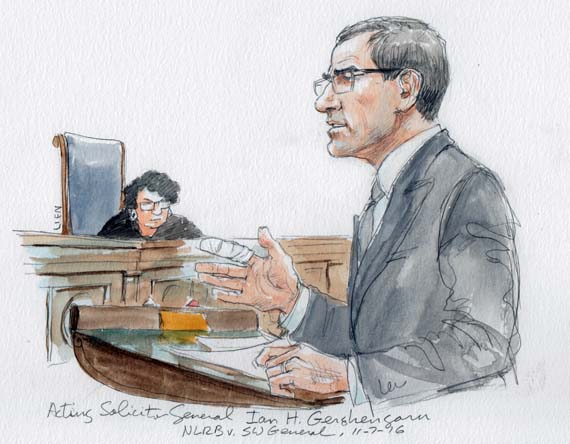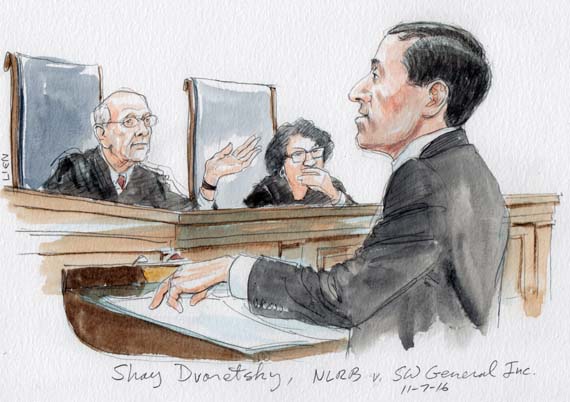Argument analysis: Justices divided in appointments case

on Nov 7, 2016 at 5:33 pm
Today the justices heard oral argument in a challenge to the government’s interpretation of the Federal Vacancies Reform Act of 1998, a law that (among other things) allows the duties and responsibilities of an executive branch official who requires Senate confirmation to be carried out by someone else, serving in an acting capacity. As I explained in my preview of the case, the question before the court today was the scope of a provision that bars the president from nominating someone who is serving in an acting capacity to fill the job on a permanent basis unless the acting official also served as the first assistant to the vacant position for at least 90 days in the year before the job became vacant. Does the provision apply only to first assistants who are serving in an acting role, as the government contends, or does it also extend to the other two categories of individuals who can serve in the acting role – individuals who have already been confirmed by the Senate to another position and senior officials in the same government agency?
The issue arose when the National Labor Relations Board, a federal agency tasked with addressing unfair labor practices by private employers, initiated a proceeding against SW General, which operates an ambulance service in Arizona. The NLRB’s general counsel at the time was Lafe Solomon, a longtime NLRB employee whom President Barack Obama had appointed as the acting general counsel. Obama had nominated Solomon to serve as the permanent general counsel, but that nomination was withdrawn after the Senate failed to act on it. After the NLRB ruled against it, SW General appealed to the U.S. Court of Appeals for the D.C. Circuit, arguing that Solomon could not serve as the acting general counsel because he had been nominated to be the permanent general counsel.
After an hour of oral argument, the justices appeared divided. Some of the justices did not seem to regard the text of the FVRA as particularly illuminating. Justice Elena Kagan, for example, suggested to Ian Gershengorn – who, as Chief Justice John Roberts seemed to emphasize at the start of the argument, serves as the acting U.S. solicitor general, appearing on behalf of the federal government – that the text is “peculiar.” But Kagan was similarly dubious about SW General’s reading of the text. She told Shay Dvoretzky, who argued on behalf of SW General, that it would be “a very strange drafter” who would draft the statute as it currently reads to reach the result that SW General suggests.

Acting Solicitor General Ian H. Gershengorn (Art Lien)
Justice Anthony Kennedy, on the other hand, seemed to see more answers in the text. He told Dvoretzky that he had a “very strong” argument based on the text: the reference by the provision at issue to “a person” who serves in an acting capacity “under this section,” which could be construed as applying the restriction on nominating someone who is serving in an acting role to all three categories of individuals who can serve in that role.
Recognizing that the text of the FVRA did not necessarily help his case, Gershengorn tried to turn the discussion in a different direction. He pointed to both the drafting history of the statute and the longstanding interpretation of the FVRA, unchallenged by Congress, as barring only the nomination of first assistants who had not already served in that position for at least 90 days.
Justice Ruth Bader Ginsburg questioned the government’s reliance on interpretations of the FVRA by the Justice Department’s Office of Legal Counsel, which provides legal advice to the president, and by the General Accounting Office, an independent agency often known as the “congressional watchdog.” The opinion from the Office of Legal Counsel isn’t particularly helpful to you, she told Gershengorn, because there was no real discussion of the interpretation of the statute – simply a question and an answer, without any explanation for that answer. Similarly, Ginsburg continued, the GAO also did not specifically address whether the limitation applies to all three categories of employees or just to first assistants.
Gershengorn pushed back, telling Ginsburg that the letter from the GAO is clear. More importantly, he emphasized, Congress has always been aware of this reading of the statute and has never objected to it, during either Democratic or Republican administrations.
That assertion drew criticism from Roberts, who told Gershengorn that the federal government’s position puts a significant burden on Congress to either speak up whenever it disagrees or face being bound by its silence. This is especially problematic, Roberts continued, when there may be valid reasons why members of Congress wouldn’t want to object to an executive branch appointment – for example, because they wanted to see vacancies filled.
Gershengorn’s argument apparently gained more traction with Kagan, however. Addressing Dvoretzky, she acknowledged that the court is “generally reluctant” to require Congress to voice its objections to a particular practice by the executive branch. But here, she stressed, the history of executive branch appointments consistent with the government’s proposed rule is so strong, especially in the current climate of partisan bickering, that perhaps the court should give some weight to Congress’ failure to object.

Shay Dvoretzky for respondent (Art Lien)
Dvoretzky cautioned against giving too much weight to Congress’ apparent lack of objection. He explained that it is not necessarily easy to identify violations of the FVRA. However, even when members of Congress are able to do so, he continued, they may want to rely on a rationale that is more concrete than a failure to comply with the provisions of the FVRA when opposing a nomination. Kagan disagreed, telling Dvoretzky that a violation of the FVRA could provide “some real extra oomph” to oppose a nomination. Who wouldn’t want to do that? she asked, seemingly rhetorically. Dvoretzky garnered the biggest laugh of the day when he responded, deadpan, “Someone who was then going to be pressed and had to explain the technicalities of why the appointment was illegal.”
For his part, Gershengorn argued that Congress’ objections to efforts to fill vacancies were exactly what had prompted it to pass the FVRA in the first place – and, presumably, would mean that Congress would have objected again if it disagreed with how the executive branch was interpreting the statute. But when he referred to a statement by Sen. Fred Thompson, indicating that the restriction would only apply to first assistants serving in an acting capacity and not to the other two categories of officials who can serve in an acting role, two different justices expressed doubt about whether the court could rely on that statement. Ginsburg led the charge, pointing out that Sen. Robert Byrd had made a statement that supported SW General’s argument. Kennedy was even more skeptical. He told Gershengorn that, although the history of a statute certainly can play a role in understanding the context in which the law was passed, it is a very different thing “to rely on an isolated statement,” which Kennedy characterized as legislative history “at its weakest and most unpersuasive.”
Justice Stephen Breyer was more consistently sympathetic to the government. He took what he seemed to regard as a pragmatic approach, asking Dvoretzky to explain the point of a statute that authorizes the president to appoint someone from one of three different categories – the first assistant, a Senate-confirmed official, or a senior official from the agency – to serve in an acting capacity but then bars the president from nominating any of those three people to fill the role in a permanent capacity. “I can’t think of an answer” under SW General’s reading, he insisted. On the other hand, Breyer pointed out, the government’s rule addresses a specific scenario that had triggered the enactment of the FVRA: the case of Bill Lann Lee, whom then-President Bill Clinton had nominated to serve as the assistant attorney general in charge of the Department of Justice’s civil rights division. After the Senate declined to confirm Lee, a lawyer for the NAACP Legal Defense and Educational Fund, Clinton named Lee as the first assistant to the assistant attorney general position and shortly thereafter designated him as the acting assistant attorney general.
Dvoretzky attributed a different, and broader, purpose to Congress in enacting the FVRA. He countered that Congress was not only concerned with officials, like Lee, brought in from outside the government to serve in an acting capacity, but with any nominee serving in an acting capacity for the position for which she had been nominated. And that concern, he emphasized, holds true for all three categories of potential acting officials. Moreover, he added, in at least a third of all cases, the president either nominates someone to serve as a permanent replacement and simultaneously designates that person to serve in an acting capacity, or else nominates a permanent replacement and then later also designates the nominee to serve in an acting role. Either way, he noted, concerns that SW General’s rule would require the president to remove the person who is currently serving in an acting capacity in order to nominate her are overblown.
Another important issue lurked in the justices’ minds: What exactly would happen if they were to adopt SW General’s interpretation of the FVRA? Kennedy observed that the federal government’s brief did not “list a great parade of horribles.” The federal system, he posited, would be “quite capable of accommodating” the interpretation advanced by SW General.
Kagan asked Gershengorn to address the effects, if any, that a ruling against the government would have on actions already taken by government officials whose service would be deemed to be in violation of FVRA. Gershengorn indicated that such officials and their actions would be subject to “substantial uncertainty,” but Ginsburg appeared doubtful. She suggested that questions regarding the validity of actions taken by officials who were serving in violation of the FVRA may have already been waived in many cases. Kagan pressed Gershengorn to explain precisely what kinds of decisions might be affected by the court’s ruling, but it is not at all clear that she was convinced either.
Dvoretzky downplayed the consequences of a ruling for SW General as very limited, even with regard to actions that acting officials whose appointments would violate the FVRA have already taken. “If ruling in our favor were going to lead the sky to fall,” he told the justices, the government would obviously say so. But not only has the government failed to make any such suggestion, he continued, it has in fact suggested exactly the opposite – that is, that acting officials had not done anything at all that would be invalidated by a ruling for SW General.
Virtually all the tough questions for Dvoretzky came from the court’s four more liberal justices, but Kagan and Ginsburg also had hard questions for Gershengorn. Even if the federal government can get all four of the more liberal justices’ votes, however, it’s hard to see where the government could pick up the fifth vote needed to reverse the D.C. Circuit’s ruling in SW General’s favor: The remaining members of the court who asked questions – Roberts, Kennedy, and Justice Samuel Alito – all seemed to be solidly in SW General’s corner. We will likely know more sometime next year.


